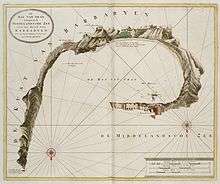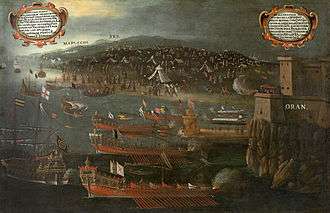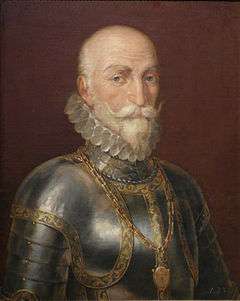Sieges of Oran and Mers El Kébir
| ||||||||||||||||||||||||||||||
The sieges of Oran and Mers El Kébir took place between April and June 1563 during the Ottoman-Habsburg struggle for the control of the Mediterranean when a huge Ottoman army under the command of Hasan Pasha, son of Hayreddin Barbarossa, and Jafar Catania, tried to conquer the Spanish-controlled strongholds of Oran and Mers El Kébir on the North African coast, defended respectively by Alonso de Córdoba, Count of Alcaudete, and his brother Martín de Córdoba. The stubborn defense of the Spanish and the arrival of a relief fleet under Francisco de Mendoza frustrated the Ottoman intentions.
Background
.jpg)
After the conquest of Tripoli to the Knights of Malta by the Ottoman admiral Turgut Reis in 1551, and the fall of Bougie to the governor of Algiers, Salih Reis, in 1555, the towns of Oran and Mers El Kébir remained as the only Christian strongholds in Barbary, along with the island of La Goulette, which helped fight the Ottoman and Moorish pirates who constantly plundered and razed the coasts of Naples, Sicily and the Levant. An Ottoman fleet composed of 50 galleys under the command of the renegade Hasan Corso besieged both cities in the Siege of Oran in 1556,[6] but the Sultan Suleiman ordered lift the siege to withdraw the galleys to serve in the Eastern Mediterranean, so both Mers El Kébir and Oran remained in Spanish hands despite the poor state of their defenses.[7]
In 1562, Hasan Pasha, son of Hayreddin Barbarossa and Ottoman governor of Algiers, purposed to conquer both towns to incorporate them into their territories of Algiers.[8] King Philip II, who was aware of Hassan's intentions, ordered assemble a fleet in Barcelona which would transport 4,000 soldiers to reinforce the small garrisons of Oran and Mers El Kébir.[8] These forces, however, never reached their destination due to a storm that destroyed the fleet on October 19 off the city of Málaga. 24 of the 27 galleys sank, and a large number of sailors and soldiers, including Don Juan de Mendoza, Captain General of the Galleys of Spain, perished.[8]
Hassan Pasha, instructed by the Sultan Suleiman, assembled soon an army of 100,000 men among Turks, Algerines and a large number of Janissaries.[3] This army was supported by sea by a fleet of 30 galleys, 5 French carracks and 15 small vessels under the command of Jafar Catania, governor of Tlemcen.[9] With these forces Hassan went to Mers El Kébir, stronghold whose dominion he considered essential to capture Oran.[9] Meanwhile, Alonso and Martin de Córdoba had received supplies, gunpowder, tools and a few soldiers from Málaga.[9] To hold together both towns in order to help each other, they decided built two forts: San Miguel, located on the hill that separated Oran from Mers El Kébir, and Todos los Santos, facing the second town.[9]
Siege
Forts San Miguel and Todos los Santos

The siege began on April 3, 1563, when Ottoman troops massively attacked the tower of Todos los Santos, defended by 200 Spanish soldiers.[9] The fierce resistance of the fort's garrison, along with artillery support from Mers El Kébir, inflicted heavy casualties on the attackers.[9] However, once the Ottoman cannons tore down the walls, the fort was soon taken.[9] Meantime Jafar's galleys blocked Mers El Kébir to prevent the city to be relieved from Oran. Ottoman's main objective was to capture Mers El Kébir, as Hassan was warned by several renegades that the Spanish planned abandon Oran to concentrate on the defense of the other town.[3] Therefore, he destined most of his troops to take the fort of San Miguel, a key point of the Spanish defense, while only a few troops remained blocking Oran.[3]
San Miguel's fort was attacked during 22 days by 24,000 infantry and 400 cavalry soldiers.[9] His few defenders rejected Hassan's offer of surrender and successfully repelled six assaults which left the moat full of dead Janissaries.[10] Among the Ottoman casualties was the governor of Constantine, whose body could be recovered by his men with the permission of Martín de Córdoba.[10] However, despite the stubbornness of the defense, the reinforcements sent from Mers el Kébir were not enough to continue fighting, and on May 8, under cover of darkness, the Spanish survivors retreated to the town.[9]
Siege of Mers El Kébir
Once inside the fort, the Ottoman troops surrounded the city, digging trenches around and placing artillery to break down the walls. On a nearby hill were also installed several culverins to bombard the inner town.[9] Martín de Córdoba, who had less than 500 men available to defend the city, prepared for the assault.[9] This one took place on 20 May. Hassan sent ahead to 12,000 alarabs to break the resistance of the Spanish harquebusiers and facilitate the assault to two columns of regular troops which would attack secondly.[11] Despite the heavy losses they suffered, the alarabs managed to scale the walls and raise the Ottoman flag on the battlements. However, the Spanish expelled them soon.[11] In that attack nearly 2,500 men died, mostly falling into the moat around the town.[12]
In the following days took place more assaults which also failed with great loss of life, although the Spanish situation he had become desperate.[3] On June 6 Hassan was about to order the final assault, when a relief fleet took his army by surprise. King Philip II had ordered a fleet to be organized in Cartagena in order to attack Hassan's army and force it to lift the siege. Under the command of Francisco de Mendoza, who was seconded by Álvaro de Bazán and Andrea Doria, 34 galleys coming from Barcelona, Naples, Genoa, Savoy, and Malta, had embarked 4,000 soldiers and many volunteer knights, and had sailed to Mers el Kébir.[13] Hassan, fearing to be trapped between the Spanish reinforcements and Mers El Kébir, ordered his troops to retreat hastily. The tents could be saved, but guns, clothing and tools were left in the field.[5] The Ottoman fleet was not so lucky, and several of its ships, including four of the French carracks, were captured.[5]
Aftermath
After disembarking reinforcements and supplies at Oran and Mers El Kébir, Francisco de Mendoza's fleet returned to Spain.[14] King Philip II, informed about the development of the siege, decided to reward Martín de Córdoba and Francisco Vivero, commanding officer of Fort San Miguel, for keeping these two crucial strongholds in Spanish hands.[14] In fact, this allowed the capture the following year of Peñón de Vélez de la Gomera, a success which was followed in 1565 by the decisive defense of Malta against the fleet of Turgut Reis.[3] Several years later, in 1574, it was discussed at the Spanish court whether or not to abandon Oran and Mers El Kébir.[15] King Philip II ordered Vespasian Gonzaga Colonna, Prince of Sabbioneta and Duke of Trayecto, to make a comprehensive report about the situation of both towns. Gonzaga advised to abandon Oran but to keep Mers El Kebir.[15] However, marshal Juan Muñoz sent to the king a report by Sancho de Leyva advising to keep both strongholds.[15] Philip II finally opted for the advice of Leyva.[15]
Notes
- ↑ Edwards/Lynch p.570
- ↑ San Miguel p.363
- 1 2 3 4 5 6 Sánchez Doncel p.180
- ↑ Fernández Duro p.49
- 1 2 3 Fernández Duro p.53
- ↑ Sánchez Doncel p.224
- ↑ Braudel p.940
- 1 2 3 Sánchez Doncel p.179
- 1 2 3 4 5 6 7 8 9 10 11 Fernández Duro p.50
- 1 2 San Miguel p.364
- 1 2 Fernández Duro p.51
- ↑ San Miguel p.365
- ↑ Fernández Duro p.52
- 1 2 San Miguel p.370
- 1 2 3 4 Sánchez Doncel p.182
References
- Fernández Duro, Cesáreo (1895). Armada Española desde la unión de los reinos de Castilla y Aragón (in Spanish). II. Madrid, Spain: Est. tipográfico "Sucesores de Rivadeneyra".
- San Miguel (duque de), Evaristo (1991). Historia de Felipe II, rey de España (in Spanish). 2. Barcelona, Spain: Salvador Manero.
- Sánchez Doncel, Gregorio (1991). Presencia de España en Orán (1509-1792) (in Spanish). Toledo, Spain: I.T. San Ildefonso. ISBN 978-84-600-7614-8.
- Edwards, John; Lynch, John (2005). Edad Moderna: Auge del Imperio, 1474-1598 (in Spanish). Madrid, Spain: Editorial Critica. ISBN 978-84-8432-624-3.
- Braudel, Fernand (1995). The Mediterranean and the Mediterranean world in the age of Philip II. 2. Los Angeles, USA: University of California Press. ISBN 978-0-520-20330-3.

